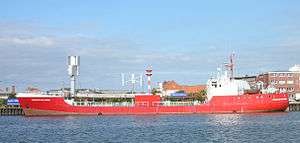Hydrogen-powered ship
A hydrogen ship is a hydrogen fueled ship, power-assisted by an electric motor that gets its electricity from a fuel cell. Or uses hydrogen fuel in an internal combustion engine.
History
In 2000, the 22-person Hydra ship was demonstrated, and in 2003 the Duffy-Herreshoff watertaxi went into service. 2003 saw the debut of Yacht No. 1, as well Hydroxy3000.[1] The AUV DeepC and Yacht XV 1 were shown in 2004. In 2005 the first example of the Type 212 submarine, which is powered underwater by fuel cells, went into service with the German navy. In 2006 the 12-person Xperiance was debuted, as well as the Zebotec. In 2007 both the 8-person Tuckerboot and the Canal boat Ross Barlow debuted, and in 2008 the 100-passenger Zemships project Alsterwasser went into service in Hamburg. Also, in 2009 the Nemo H2 and the Frauscher 600 Riviera HP went into service.[2] In 2013 the Hydrogenesis Passenger Ferry project went into service.[3]
In February 2020 it was announced that the software tycoon Bill Gates had commissioned the world’s first hydrogen-powered superyacht, in a £500m signal of his belief that investment in new clean technology is the best way to cut carbon emissions. Later, the yacht manufacturers refuted this news and claimed that they have no business relationship with Gates. [4]
The Sunday Telegraph revealed that the retired Microsoft cofounder was behind the construction of a hydrogen vessel by the Dutch yacht builder Feadship.[5]
The custom build was said to be based on blueprints for a 112-metre design "Aqua"[6]
publicised in 2019 at the Monaco Yacht Show by the Dutch marine architects Sinot.
Economy

In 2010, Hjalti Pall Ingolfsson from Icelandic New Energy has commented that ships are fast becoming the biggest source of air pollution in the European Union. It is estimated that by 2020 emissions of sulfur dioxide and nitrogen oxides from ships will exceed land-based emissions in Europe. A big issue to be dealt with would be the storage of hydrogen on ships, given that there would be no opportunity to refill them when out at sea,[7] although one can use wind power and solar panels to generate electricity from the ocean while they are far from the shores and produce onboard hydrogen.[8]
Infrastructure
The need for a hydrogen infrastructure varies, where the Yacht No. 1 was fueled by a mobile hydrogen station,[9] the prototype Haveblue Yacht XV 1 was intended to have onboard hydrogen generation, the Xperiance and Tuckerboot have exchangeable high-pressure hydrogen tanks which can be refilled at a local hydrogen station, the canal boat Ross Barlow uses fixed onboard low-pressure solid-state metal hydride storage tanks and depends on a refilling station on the waterside, the Zemships Alsterwasser refills at a fixed waterside storage tank with 17,000 liters of hydrogen which is refuelled by a compressed hydrogen tube trailer.[10]
Codes and standards
Hydrogen codes and standards have repeatedly been identified as a major institutional barrier to the deployment of hydrogen technologies and the development of a hydrogen economy. To enable the commercialization of hydrogen in consumer products, new model building codes and equipment, as well as other technical standards are developed and recognized by federal, state, and local governments.[11] The Germanischer Lloyd guidelines for fuel cells on ships and boats[12] is used for the Hydra, Tuckerboot, Yacht No. 1, Zebotec and Zemships.
Research
The NEW H SHIP project was a 15-month project that started February 2004. FC-SHIP was funded by the European Commission under FP5 - GROWTH from 2002 to 2004. The Viking Fellowship is a Nordic project.[13] The SMART H2 project started in 2007 by placing a fuel cell in the existing whale-watching ship Elding.[14] Other studies have also considered various ways of combining fuel cell operations on board with air conditioning systems for operations while in harbour.[15] In order to gain a commercial advantage, the Norwegian government scheduled money for a regular hydrogen car ferry in 2016, to be operational in 2021. New rules are viewed as more challenging than developing the technology.[16]
In early 2020, the e5 Project began to design a hydrogen cell and battery powered tugboat.[17]
See also
References
- "Hydroxy 3000". Archived from the original on 2008-11-12. Retrieved 2008-08-07.
- Hydrogen for Frauscher Riviera 600 Archived 2011-07-22 at the Wayback Machine
- Hydrogenesis passenger ferry, United Kingdom
- "Bill Gates 'not buying our hydrogen yacht'". BBC News. 10 February 2020.
- https://www.telegraph.co.uk/news/2020/02/08/bill-gates-becomes-first-buy-500m-hydrogen-powered-super-yacht/
- https://www.esquireme.com/content/43359-bill-gates-just-bought-a-645-million-green-luxury-super-yacht
- NEW H SHIP
- http://www.greenoptimistic.com/2010/05/29/sailing-ships-hydrogen-energy-oceans/
- Hytra Archived 2007-06-10 at the Wayback Machine
- Zemships Archived 2012-12-03 at the Wayback Machine
- DOE codes and standards
- Guidelines for the use of fuel cell systems on board of ships and boats
- DNV Fellowship
- Elding
- Kar Chung Tse, Lawrence (2011). "Solid oxide fuel cell/gas turbine trigeneration system for marine applications". Journal of Power Sources. 196: 3149–3162. doi:10.1016/j.jpowsour.2010.11.099.
- "Hydrogenfergen vil koste 100 millioner kroner ekstra - det sponser staten". Teknisk Ukeblad. Retrieved 25 November 2016.
- "e5 Lab". e5 Ship (in Japanese). Retrieved 2020-05-27.